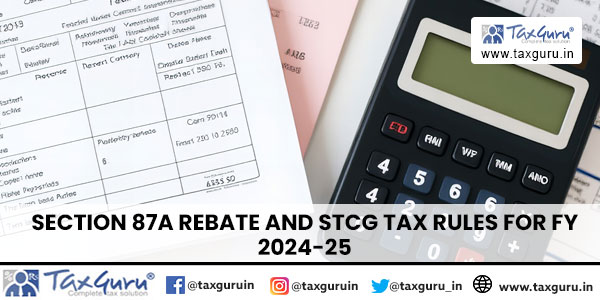Summary: Under the new tax regime for Financial Year 2024-25, individuals with a total income up to ₹7,00,000 are eligible for a rebate under Section 87A of the Income Tax Act. This rebate is either equal to the tax payable on total income or ₹25,000, whichever is lower, and is applicable only to resident individuals, excluding non-residents, firms, and companies. Notably, this rebate does not apply to special rate incomes such as Short-Term Capital Gains (STCG) under Section 111A. For rebate calculation, total income is considered excluding STCG or other incomes taxed at special rates. Tax is first computed on the total income (excluding cess and surcharge), the rebate is applied, and only then cess and surcharge are added. STCG under Section 111A applies to gains from listed equity shares or mutual funds held for 12 months or less. From July 23, 2024, the STCG tax rate increases from 15% to 20%. The basic exemption limit remains ₹3,00,000 for all taxpayers regardless of age, and this exemption can be adjusted against STCG income. A series of examples highlight scenarios where individuals earn a mix of salary and STCG. Incomes solely composed of STCG or combined with other incomes under ₹3,00,000 remain tax-exempt. However, when total income excluding STCG exceeds ₹7,00,000, the rebate is disallowed. In such cases, only regular income is eligible for rebate, and tax on STCG must be paid at the applicable rate. Additionally, deductions under Chapter VI-A and marginal relief are not available against STCG. Marginal relief under Section 87A is provided if tax liability increases disproportionately with income just above ₹7,00,000, but only within narrow limits. These rules aim to separate regular income from capital gains and ensure targeted tax relief.

Rebate u/s 87A of Income Tax Act along with STCG u/s 111A for the financial year 24-25 under new tax regime:
1. Rebate u/s 87A:
Rebate under this section will be available if total income of the assessee for the financial year 24-25 is upto Rs 7,00,000.
2. Rebate calculation:
Tax payable on total income
Or
Rs 25,000 (it is fixed amount u/s 87A)
Whichever is lower will be the rebate amount.
3. How to calculate tax payable for rebate: Tax will be calculated on the total income without considering the surcharge & cess for the purpose of determining the rebate. Surcharge & cess will be levied after deducting the rebate amount.
4. Eligible taxpayers: Only individual resident can avail the benefit of this section irrespective of the age. Non-resident individuals, firms or corporates etc. are not eligible to avail the benefit of this section.
5. Computation of total income: For the purpose of this section, total income excludes the special rate income i.e STCG u/s 111A or LTCG u/s 112A etc. If total income excluding special rate income is not exceeding 7,00,000 benefit of rebate can be availed.
6. Rebate benefit not for special rate income: The benefit of rebate cannot be applied against special rate income.
7. STCG u/s 111A:
a. This section covers capital gain on the sale of listed shares or equity oriented mutual funds etc.
b. If securities sold within the 12 months it will be treated as a short term capital gain or loss. If sold after 12 months then these will not be fall under this section. It will be covered u/s 112A.
c. Tax rate:
i. Tax will be levied @20% on STCG if shares sold on or after 23rd July 2024 in the financial year 24-25.
ii. Tax will be levied @15% on STCG if shares sold before 23rd July 2024 in the financial year 24-25.
d. There is no other benefit under this section like in Sec 112A, there will be no tax on LTCG of Rs 1,25,000.
8. Basic exemption limit: Under new tax regime, basic exemption limit is 3,00,000 irrespective of the age of individual. Benefit of basic exemption limit applies to all the incomes like salary, interest, house property income, STCG or LTCG etc.
9. Example 1:
Income of Mr. Ashish is
| Sr No | Particulars | Amt |
| 1 | Salary | – |
| 2 | Interest on FD | – |
| 3 | Saving bank Interest | – |
| 4 | STCG u/s 111A | 2,00,000 |
| 5 | Gross total income | 2,00,000 |
| 6 | Less: Deductions | – |
| 7 | Total income | 2,00,000 |
The tax liability will be zero in this case because the benefit of the basic exemption limit can be applied against STCG.
10. Example 2:
Income of Mr. Ashish is
| Sr No | Particulars | Amt |
| 1 | Salary | 1,00,000 |
| 2 | Interest on FD | – |
| 3 | Saving bank Interest | – |
| 4 | STCG u/s 111A | 2,00,000 |
| 5 | Gross total income | 3,00,000 |
| 6 | Less: Deductions | – |
| 7 | Total income | 3,00,000 |
The tax liability will be zero in this case because the benefit of the basic exemption limit can be applied against both income.
11. Example 3:
Income of Mr. Ashish is
| Sr No | Particulars | Amt |
| 1 | Salary | 4,00,000 |
| 2 | Interest on FD | 20,000 |
| 3 | Saving bank Interest | 20,000 |
| 4 | STCG u/s 111A | 2,00,000 |
| 5 | Gross total income | 6,40,000 |
| 6 | Less: Deductions | – |
| 7 | Total income | 6,40,000 |
Total income for the purpose of rebate is 4,40,000 ** excluding special rate income. Rebate can be applied against normal income. Hence there will be no tax liability on normal income. Tax liability will be 40,000 (2,00,000 * 20%) because the benefit of rebate cannot be applied against special rate income.
** At the time of computation of total income for calculating rebate, special rate income will not become part of total income. Hence in this case, total income is 4,40,000 instead of 6,40,000.
12. Example 4:
Income of Mr. Ashish is
| Sr No | Particulars | Amt |
| 1 | Salary | 6,00,000 |
| 2 | Interest on FD | 20,000 |
| 3 | Saving bank Interest | 20,000 |
| 4 | STCG u/s 111A | 2,00,000 |
| 5 | Gross total income | 8,40,000 |
| 6 | Less: Deductions | – |
| 7 | Total income | 8,40,000 |
Total income for the purpose of rebate is 6,40,000** excluding special rate income. Rebate can be applied against normal income. Hence there will be no tax liability on normal income. Tax liability will be 40,000 (2,00,000 * 20%) because the benefit of rebate cannot be applied against special rate income.
** At the time of computation of total income for calculating rebate, special rate income will not become part of total income. Hence in this case, total income is 6,40,000 instead of 8,40,000.
13. Example 5:
Income of Mr. Ashish is
| Sr No | Particulars | Amt |
| 1 | Salary | 7,00,000 |
| 2 | Interest on FD | 20,000 |
| 3 | Saving bank Interest | 20,000 |
| 4 | STCG u/s 111A | 2,00,000 |
| 5 | Gross total income | 9,40,000 |
| 6 | Less: Deductions | – |
| 7 | Total income | 9,40,000 |
Total income for the purpose of rebate is 7,40,000** excluding special rate income is exceeds the rebate limit. In this case, there will be no rebate on normal income.
** At the time of computation of total income for calculating rebate, special rate income will not become part of total income. Hence in this case, total income is 7,40,000 instead of 9,40,000. Assessee will pay the tax on total income i.e. 9,40,000.
14. Note:
a. The benefit of basic exemption limit can be applied to STCG u/s 111A.
b. For calculating total income u/s 87A excludes the special rate incomes.
c. The benefit of rebate cannot be applied to STCG u/s 111A.
d. The benefit of Ch. VI(A) deductions are not allowed against special rate incomes.
e. Marginal relief cannot be applied against special rate incomes.
15. Marginal relief:
If income of the assessee exceeds 7,00,000 in such cases rebate will not be available but marginal relief will be available.
a. Tax liability is zero if income of the assessee is upto 7 lakhs. However, if the income of the assessee is 7,20,000 then total liability will be 22,000. While the income has increased by 20,000 but tax liability has increased by 22,000 in such cases tax liability will be the difference between total income reduced by 7,00,000.
Hence, tax liability will be 20,000 in this case.
b. Tax liability is zero if income of the assessee is upto 7 lakhs. However, if the income of the assessee is 7,30,000 then total liability will be 23,000. While the income has increased by 30,000 but tax liability has increased by 23,000 in such cases benefit of marginal relief cannot be applied.
Hence, tax liability will be 23,000 in this case.
*****
In case of any queries you may reach out to me at caashishsingla878@gmail.com.
Disclaimer: The views & opinions expressed in this article are solely those of the author. The contents of this article are solely for informational purpose. It does not constitute professional advice or recommendation. Readers should consult with a qualified professional or tax advisor before making any decisions based on the content of this article. Author will not accepts any liabilities for any loss or damage of any kind arising out of any information in this article nor for any actions taken in reliance thereon.






The increase in STCG tax rate from 15% to 20% effective July 23, 2024, is a significant shift that many retail investors might overlook. While the ₹7L rebate under Section 87A still provides relief on regular income, excluding special rate income like STCG narrows the benefit drastically for those with even moderate equity investments. The lack of marginal relief for capital gains adds another layer of complexity. Surprising that in a “simplified” new tax regime, equity investors are being silently penalized. Shouldn’t capital market incentives align with long-term wealth building?
You bring up a valid point about the need for a tax structure that aligns more with long-term wealth building. Ideally, policies should encourage saving and investing, rather than penalizing investors who are contributing to economic growth through the stock market. The lack of clear incentives for equity investors could end up discouraging participation, which isn’t ideal in the long run for the economy or for individual wealth accumulation. It would be beneficial if policymakers reconsidered this shift to ensure that capital markets remain an attractive option for investors, especially those looking to build long-term wealth.